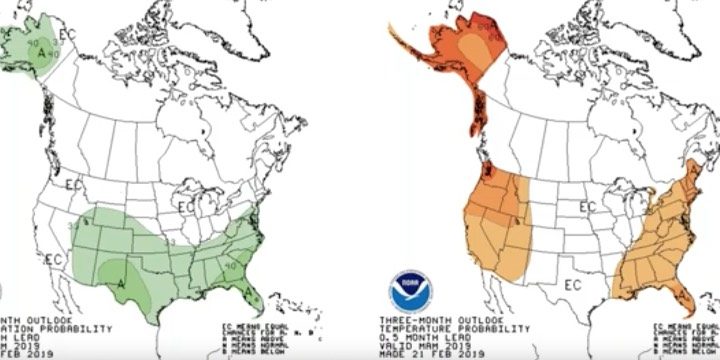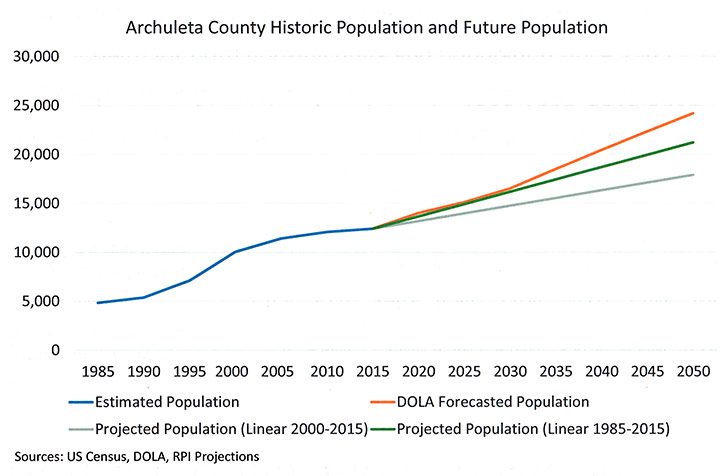I wasn’t living here in Pagosa Springs during the mid-1980s, when a downturn in the Texas oil industry was having a negative impact on the Archuleta County economy. I understand some working class folks left town, looking for jobs elsewhere, and there was a cynical joke going around town:
“Will the last family out of Pagosa please turn out the lights?”
I suppose the joke could have been “…please drain the water lines so they don’t freeze…” but for some reason, that wasn’t the joke I heard. At any rate, the lights stayed on, and the water lines didn’t freeze, and the local economy rebounded. The recovery was rather remarkable, in fact.
NOAA — the National Oceanic and Atmospheric Administration — posted a YouTube webinar yesterday, looking mainly at the likely effect of our recent snowy winter on the extreme drought of 2018, with particular focus on the Rio Grande River basin… just over the mountains from Pagosa Springs on the eastern slope of the Continental Divide.
It’s a 39-minute webinar, and probably ‘less than fascinating’ for many people… but it did include the following map which may be of interest. The map shows, on the left, a February forecast of possible precipitation patterns for March, April and May of 2019. (The map on the right shows probable temperature patterns.)
The green color in the precipitation map indicates that NOAA believes it’s likely that Utah, Colorado, Arizona, New Mexico and the entire southern US will have above-average precipitation going into the summer of 2019:
Which does not necessarily mean “above-average river flows.” Before snowmelt can make it into the rivers, the soil gets first dibs on any extra moisture, and here in Southwestern Colorado, the soil was pretty doggone dry as of last October. So even if our snowpack is at 150 percent, that doesn’t necessarily mean we will have 150 percent in the San Juan River.
The soil gets to soak up its share, first.
Predicting weather and river flows, three months into the future, is still guesswork at NOAA, even with all their fancy new satellites and radar stations. But we can be very sure of one thing: we are going to have weather of one kind or another. And we will then be able to figure that weather into an “average” that we can then use next year, when we talk about “above average” or “below average.”
As a new member of the San Juan Water Conservancy District board of directors, I find this sort of video webinar intriguing. Not necessarily because it’s accurate — although it might be — but because of what it says about human nature, and about our fascination with planning for the future. Two years ago, before I was appointed to the SJWCD board, Board President Rod Proffitt was guiding the District towards an uncertain future. Mr. Proffitt and his friends on the SJWCD board had negotiated a $2 million loan from the Colorado Water Conservation Board for the purpose of acquiring additional property in the Dry Gulch valley northeast of downtown Pagosa. But to finance that proposed loan, SJWCD needed a decent flow of tax revenue, so Mr. Proffitt and his friends were planning to put a mill levy increase before the voters in November.
The property was necessary for a future Dry Gulch Reservoir, should such a facility be built someday. Someday, far into the future.
Predicting weather and river flows over the next three month, using satellite and radar data, and high-powered computers, is a tricky prospect.
Predicting the need for an 11,000-acre-foot water reservoir thirty years from now? Well, that’s a piece of cake. You simply hire a Durango water engineer (who gets makes his money helping water districts design water reservoirs) and he’ll tell you: Hell yes, you guys will really need to spend $100 million or so constructing a dam in a dry valley that has no significant water flowing through it, and you better get started right now, because that’s a lot of money to collect from the taxpayers.
Mr. Proffitt and the SJWCD board were unable to convince the taxpayers to increase their own taxes in 2017, to help pay for an 11,000-acre-foot reservoir in the Dry Gulch valley. But the board did spend a pretty penny on the election effort, mostly in the way of attorney fees.
Making predictions about the future is always tricky, but I could have told Mr. Proffitt that the mill levy increase was going to fail. If he’d asked me. Which he didn’t.
I have less confidence that I understand where Pagosa Springs Town Planner James Dickhoff and the Sonoran Institute are headed with the Growing Water Smart population increase effort. We’ve looked at the outcome of that year-long effort earlier in this editorial series: a simple chart that predicts a range of possible population counts in 2050:
The high end prediction for Archuleta County is about 24,000 by 2050. Roughly double our current county population. The low end prediction is around 18,000 — an increase of maybe 5,000 people.
As I mentioned in Part Two, this prediction was basically a ‘straight-line’ guess by Durango-based RPI Consulting. Consultant Gabe Preston looked at the population growth between 2000 and 2018 and drew a couple of straight lines projecting the same growth rates into the future. As far as I can tell, Mr. Preston did not make a careful analysis of the many, many factors that will influence population growth over the next 30 years. (Such an analysis would have cost more money.)
For example, RPI did not calculate how much water will be flowing down the San Juan River in 2050.
Why do we make these kinds of predictions? We can’t even predict accurately, in October, the winter snowpack in the mountains in February. But we want to project a community’s population 30 years in the future?
I will go out on a limb and offer a theory about human nature.
Government workers want job security, just like the rest of us. If the population of Archuleta County were to diminish — if our community were to shrink as it did from 2008 through 2011 — property values would fall, property taxes would drop, sales tax collections would decline. Not only would local businesses have less income; our government agencies would also see their revenues drop. Employees would be laid off.
This is exactly what happened here during the Great Recession. We all had to tighten our belts.
If you believe in magic, you might believe that publishing a chart of future population growth will help your desired future come to pass. You will want to show that our community is destined to grow — perhaps quickly, or maybe more slowly — but certainly we will see growth. Our government revenues will also grow, and our local businesses will continue to thrive. We can safely plan for a future where we’ll have more and more money to spend, on more and more projects and programs.
And we will be happy.



